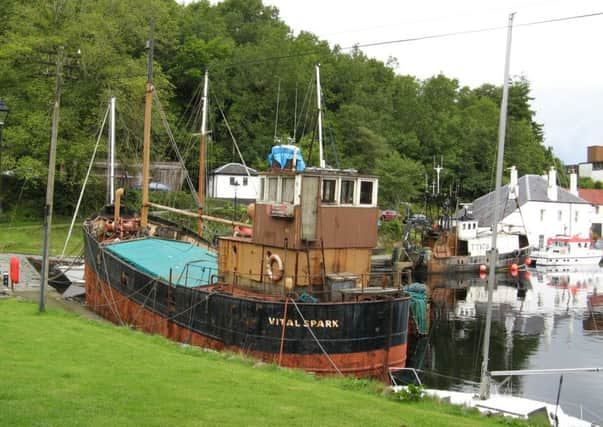Little puffers played a big role in war


Being small and stubby, it seemed natural to refer to the puffers as boats, rather than ships. Designed to carry goods along the Forth and Clyde Canal, their shape was dictated by the canal locks, which limited their length to less than 66ft, with a beam of 14ft and a draught of 7ft.
When they were confined to the canal, they used the canal water, but in the Firth of Forth and the River Clyde, they carried 12 tonnes of water for the boiler. Bunker capacity was 11 tonnes, which they burned at about 2cwt per hour, and the hold capacity was 80 tonnes.
Advertisement
Hide AdAdvertisement
Hide AdThe crew consisted of the captain, engineer and a deckhand. Cargos had to be loaded between tides, using the mast-mounted derrick, especially if the boat was beached because of the absence of moorings at smaller communities. Beaching required great care to avoid the bottom being torn by submerged rocks. The necessary knowledge came from long experience. It was said that captains had few certificates, but huge knowledge in their heads, which was where it mattered.
With the extension of the puffers’ operation to the Clyde waters and islands, designs were lengthened to a maximum of 88ft, the limit in the Crinan Canal locks, which increased the hold capacity to 120 tonnes and required another deckhand.
In 1905 Neil Munro, of Inveraray, started to write articles for the Glasgow Evening News about a fictional puffer called The Vital Spark and its skipper Para Handy. These soon became books, which have never been out of print, and led to three BBC television series.
During the First World War the boats were used to supply the Royal Navy’s ships in Scapa Flow. After the war, the flood of ex-army motor vehicles onto the market led to many small haulage businesses being set up and taking traffic, and the improvement of roads resulted in quicker deliveries, so the puffers lost trade.
Advertisement
Hide AdAdvertisement
Hide AdThe Admiralty was quick off the mark in 1939 and immediately ordered 64 of the little boats, which it designated Victualling Inshore Craft (VICs). The number increased to 98, the order for numbers 99 and 100 being cancelled as the war finished.
The last puffer in normal service was withdrawn in 1993. This was VIC 72, which has been renamed The Vital Spark and is preserved at Inveraray. There is a reduced-size replica on the Forth and Clyde Canal for tourist traffic.
On the railway, 2018 is to be a big year. We are due to see the start of local services between Edinburgh and Berwick, including the re-opening of Reston station, as part of a hike in Scotrail’s provision.
The electrification of lines in the central belt, including 70 new electric trains, will release diesel trains to non-electrified lines, including the Borders Railway, whose trains will grow from two to three coaches. One train per hour from the Borders will continue into Fife.
Advertisement
Hide AdAdvertisement
Hide AdTwenty-seven refurbished ‘High-speed Trains’, released from services in England as a result of electrification, will come to Scotland for longer services connecting the largest cities.
Trans-Pennine Express services will be promoted to Inter-city status, including from 2019 extension of its Liverpool to Newcastle services to Edinburgh. This will also restore long-distance services to Morpeth, which Virgin Trains had begun to develop before it lost the Cross-Country franchise to Arriva, which declined to maintain them because they were not required by the franchise.
As of May 15 Berwick is having one or two new direct services from places south of York, such as Peterborough, while losing an equivalent number of services that have run non-stop between London and York.
• John Wylde is the author of Integrated Transport — a Will-o’-the-wisp?, £14.95, post paid and signed. Also Experiments in Public Transport Operation at £11.95. Order at www.john-wylde.co.uk